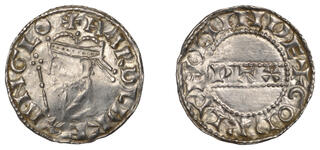| Noonans (formerly Dix Noonan Webb) > Auction 290 | Auction date: 21 February 2024 |
| Lot number: 1059 Price realized: 3,400 GBP (Approx. 4,288 USD / 3,969 EUR) Note: Prices do not include buyer's fees. | Show similar lots on CoinArchives Find similar lots in upcoming auctions on |
| Lot description: Harold II Harold II (1066), PAX type with Sceptre [BMC I; N 836; S 1186], Penny, London, Godric, Gp A, +hardld rex anglo, rev. +godric n lvnde, 1.25g/9h (Bt 71, this coin; Pagan, NM p.192 [seven examples noted]; BMC 61ff; SCBI NM 1081, same obv. die). Softly struck, very fine, excellent metal; struck from dies of curious manufacture £900-£1,200 --- Struck from the same obverse die as Braintree 68-9 The fourth letter of the king's name is distinctively shaped, with the two pronounced sinister serifs giving the character the appearance of a D. While the significance of this is not immediately apparent, it is curious that the same feature can be found on an obverse die employed at Thetford, also under a moneyer Godric (Braintree 113). Godric struck at London throughout the reign of Edward, while his namesake was active at Thetford during the last three types of the Confessor's reign. This coin is irregular in additional respects. For one, the crown is unusually crude, extending beyond the back of the head in a quite awkward fashion, a feature also seen on a London penny of Eadwine (Braintree 67). The reader should also note the short copulative N employed on the reverse, a most unusual feature in this period. Gareth Williams, in discussing the Chew Valley hoard, noticed the presence in that assemblage of several coins of Harold signed by Godric which carried blundered London mint signatures: ovnd and svni. We should also recall that Godric at London was one of the very few moneyers who struck coins under Harold with a right facing bust (SCBI Mack 1344). London appears to have been the centre of die-cutting within England, and we might expect that the dies used within that city would adhere closely to the stipulated standards and models. That such alterations could be made and tolerated suggests a breakdown in administrative authority; it is tempting to associate the various irregular coins of Godric with the chaos that surrounded the final weeks of Harold's reign and the aftermath of his death on the 14th of October. |  |


